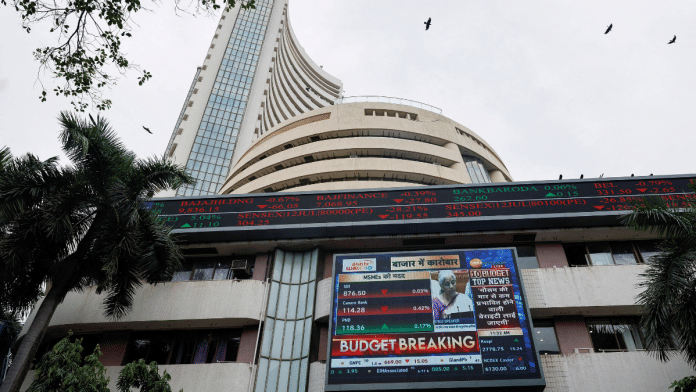New Delhi: Indian stock markets were hit hard Monday, with the Sensex plunging by over 2,300 points and the NSE Nifty dropping by over 400 points amid rising global geopolitical tensions and fears over a possible recession in the US.
The Sensex opened at 78,588 points while Nifty50 opened at 24,108 points Monday. By the markets closed, Sensex had settled at 78,768.42, down 2,222 points or 2.74 percent, after nearly touching a 3 percent drop at 78,588. The Nifty50 also ended the day sharply lower, tumbling 662 points or 2.68 percent to close at 24,055, after touching the day’s low of 23,893, a decline of 3.33 percent.
The fall in the Indian market reflected sharp falls in Asian markets, with the stock market in Japan falling by 12 percent, the most drastic drop since October 1987.
The India VIX, a measure of market volatility, soared to 20.37 points, an increase of 42.23 percent, signalling extreme market volatility.
The bearish sentiment was widespread, with 45 of the 50 listed stocks on the Nifty50 ending in the red. The biggest losers included Tata Motors, ONGC, Adani Ports, Tata Steel, and Hindalco, each falling over 7 percent. On the Bombay Stock Exchange (BSE), 28 out of the 30 Sensex constituents closed lower, led by declines in Tata Motors and Adani Ports. Only Hindustan Unilever and Nestle India managed to post gains.
The broader indices also suffered, with Smallcap and Midcap indices dropping more than 4 percent. Sectoral indices were not spared, with losses in the Auto, Metal, IT, and Banking sectors reaching up to 4.85 percent. The overall market capitalisation of firms listed on the BSE fell from nearly ₹457 lakh crore in the previous session to about ₹442 lakh crore, leading to an investor loss of nearly ₹15 lakh crore in just one session.
What led to the market decline?
The bearish trend in Indian markets can be attributed to a global slowdown influenced by three main factors: appreciation of the Japanese Yen against the US dollar, a report on the US job market that sparked fears of a possible recession and the rising geo-political tensions in the Middle East.
Vinod Nair, Head of Research at Geojit Financial Services, explained: “The global market was jolted into a cautious mode by recessionary fears in the US following disappointing job statistics and unwinding of carry trade following the rapid rise of the yen. The effects were felt by the domestic market as well and are expected to impact in the near term.”
The Japanese yen rose as much as 2.94 percent intraday to 142.22 against the US dollar, its highest level since 4 January, before trading at 143.42. The Bank of Japan increased its benchmark interest rate to 0.25 percent, from a range of 0-0.1 percent, marking the second hike since ending its ultra-loose policy earlier this year.
Investors have expressed concern about the unexpected increase in funding currencies, as the Yen and Chinese Yuan are frequently employed for carry trade.
A carry trade is a popular trading strategy in which an investor borrows money from a country with low interest rates using a weaker currency (Japan in this case) and reinvests the money in another country’s assets, yielding a better rate of return. It has been a major source of flows in the global currency market. Low volatility, yen-funded carry trades were the most popular, with investors betting that Japanese interest rates would remain at rock bottom.
Also read: 71% of intraday traders incur losses, finds SEBI report. Impact higher among young, small traders
Japan’s Nikkei N225 index shed a staggering 12 percent to hit nine-month lows, entering bear market territory and marking its biggest one-day percentage drop since October 1987.
A disappointing US jobs report showed a significant slowdown in hiring for July, with unemployment rising to its highest level in nearly three years. This deepened fears of a cooling US economy led Goldman Sachs to predict that the Federal Reserve would cut interest rates at its next three meetings, a more aggressive approach than previously expected. Global share markets tumbled and bonds rallied as investors moved away from risk assets on recessionary fears.
Furthermore, the ongoing Israel-Hamas conflict, intensified by the recent killing of Ismail Haniyeh in Iran, has heightened geopolitical tensions. This conflict, active since October last year, has impacted global oil demand and trade, adding to the disruptions caused by the Russia-Ukraine war and subsequent sanctions on Russia.
Domestic fluctuations add to the market downturn
Indian stock valuations, especially in the mid and small-cap segments, remained high due to sustained liquidity flows, meaning overvalued sectors like defence and railways are likely to face pressure.
Foreign Portfolio Investments (FPIs) withdrew nearly $1.27 billion from the stock market over three days following the government’s announcement of higher taxes on derivatives trades and capital gains from equity investments in the 2024 Union Budget. Stock exchange data showed that FPIs sold equities worth Rs 2,975 crore on the day the Budget was announced (23 July), and an additional Rs 7,735 crore in the following days.
V K Vijayakumar, Chief Investment Strategist at Geojit Financial Services, advised investors to wait for market stabilisation before making new investments. He recommended focusing on fairly valued large-cap stocks and defensive sectors like FMCG and Pharma once the market stabilises.
“When valuations are high, unexpected triggers will cause sharp cuts. This is happening now with fears of recession in the US and geopolitical tensions in the Middle East. Investors should wait for the market to stabilize before jumping into fresh investments,” he said.
Nair added that Indian markets have historically shown resilience to global disturbances and have outperformed compared to global markets in the long term. He predicted a strong bounce-back, supported by robust GDP growth, progressive policies, fiscal prudence, and a favourable political landscape.
(Edited by Sanya Mathur)
Also read: Budget 2024: Stock market plummets as Sitharaman hikes taxes on capital gains, then recovers







Good information